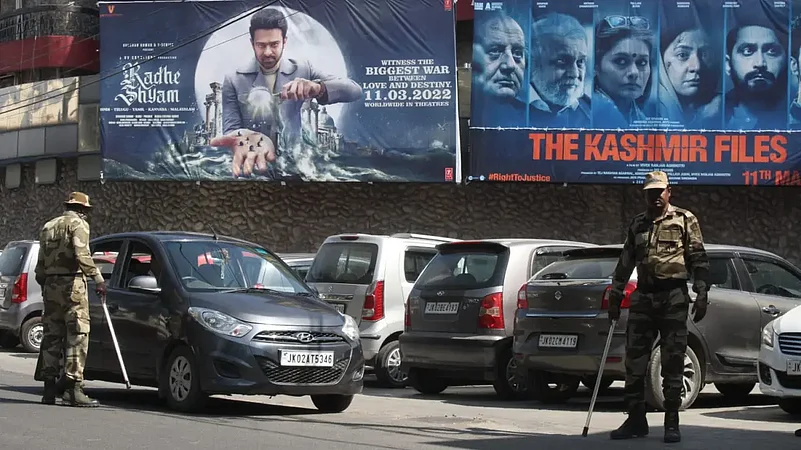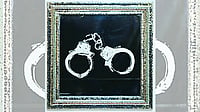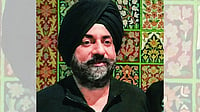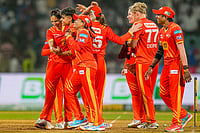At Jaipur Literary Festival 2015, Ravinder Kaul, a noted Jammu based art critic, had posed a direct question to Vishal Bhardwaj regarding the invisibilization of Kashmiri Pandits in ‘Haider’. While answering, Bhardwaj asked Kaul a counter-question, “Did you ever ask this question to (Vidhu) Vinod Chopra, he is a Pandit himself?” When Kaul responded negative, Bhardwaj asked, “Then why grill me?”
Sharing this incident with a video clip on Facebook recently, Kaul wrote on March 22, “His answer is the perfect rejoinder to those who are asking Vivek Agnihotri why he is silent about the tragedy of Kashmiri Muslims while speaking about the sufferings of Kashmiri Hindus.”
In Jammu, which is home to the majority of the Kashmiri Pandit families who got displaced after the onset of militancy, ‘Kashmir Files’ has fueled polarisation in the community. While one group describes the movie as a true testimony of their loss and painful memories, the other deplores that it undermines the reconciliation between the two communities, complicating their return and rehabilitation in Kashmir valley.
During the first week of the movie’s release, theatres in Jammu remained jam-packed. Many so-called cultural organisations mobilised Kashmiri Pandits to make sure that they watch the movie. Fiery slogans and speeches were delivered inside theatres at the end of the movie that shows the Nadimarg massacre wherein 24 community members were killed by Lashkar-e-Taiba terrorists in Kashmir’s Pulwama district in 2003.
But when this reporter watched the movie at the city's Wave Cinema on March 22 evening, nearly half of the seats were empty. The viewers, Muslims included, watched the movie and then left the hall silently.
Some demonstrations and rallies were also held in support of the movie soon after some community members criticised it in the media.
Sunil Pandita, a social activist and community member, has alleged he is getting death threats for describing the movie as “politically motivated”. Maintaining that the police hadn’t registered his complaint, Pandita, who lives in Jagati township, told Outlook, “Neither does the film offer any solution to the problems of the displaced Pandits nor does it benefit the country in any way.”
Sampat Prakash, 86, a prominent Kashmiri Pandit and a trade unionist, also called out the movie for showing all the Kashmiri Muslims in bad light. “Whether it is the majority community of Kashmir including Shias, Sunnis, Gujjars and Bakarwals or the Sikhs, everyone is suffering here in this dark era of Kashmiri civilisation that has been marked by death and destruction. Thousands of young men (from the majority community) have died or disappeared so far. Custodial deaths and crackdowns continue,” he said.
“Only reconciliation and dialogue can offer a solution,” he continued, adding that the film was creating a communal atmosphere. “Among others, the movie should have included Kunan Poshpora, Chattisinghpora, Wandhama and Gawkadal tragedies as well.”
While he rebutted the genocide claims, he said, “It’s true that over 200 Kashmiri Pandits were selectively killed. They were targeted. But I have been observing for the past several years when a member of non-migrant Kashmiri Pandit community dies in Kashmir, it is the members of the majority community who — going against the tenets of their own religion — not just mourn the death but also carry the body on their shoulders and cremate it as per Hindu rituals. How could the filmmakers ignore such facts?”
When the tallest leader of the community Pt Tika Lal Taploo was killed by the terrorists, Prakash said, “A large number of Muslim men participated in his funeral. Almost everyone mourned his death irrespective of the fact that he was a Bharatiya Janata Party leader.”
Sonakshi Kaul (not her real name), who is working as a government teacher in Anantnag under Prime Minister’s Rehabilitation Package — which was started by the Manmohan Singh led UPA government in 2008 — told Outlook, “When a Sikh principal and a Pandit teacher were shot dead in October last year, our local Muslim colleagues accompanied migrant Pandit employees to their residences without worrying about their lives. Then they arranged vehicles to ensure that we reached Jammu safely. We can’t imagine working in Kashmir without the support of the local Muslims.”
There are about 4,000 migrant Kashmiri Pandit employees in the Valley who have been working under the PM’s rehabilitation package. Over 1,900 additional employees are going to take up jobs under the package in the near future. “While there is a requirement of 6,000 residential units for them, the successive governments could create only 1,000 units so far,” she said, adding, “If all the Muslims are villains, as it has been shown in the movie, where do the rest of the Pandit migrant employees live? They live in the houses of the local Kashmiri Muslims.”
Gurmeet Singh, 63, a resident of Baramulla who migrated to Jammu along with Pandits in 1990 and lives in Jagati township, told Outlook, “The movie should have shown the sufferings of Sikhs and Muslims as well. We hope the director and producer of ‘Kashmir Files’ will make another film that tells the entire truth to the world.”
MK Bhat, another Kashmiri Pandit who lives in the Lale Da Baagh area near Jammu, said, “This movie is a slow poison for all those Pandits who live in Kashmir. It has made the return and rehabilitation of Pandits difficult as it deepens the distrust between two communities.”
Amid a raging debate on the one-sided movie, there are community members like Rajesh Raina, who despite being strong votaries of “Kashmiriyat”, have expressed their gratitude to the filmmaker.
In his Facebook post dated March 13, Raina stated, “Our real story was never told, never heard and never documented. Our community is really grateful to Vivek Agnihotri ji for showing our side without any adulteration.”
Over five years ago, Raina had shot and posted a video on Facebook on May 27, 2016, with a comment, “Aik pehlu ye bhi hai Kashmir ki tasveer ka — This is yet another side of the Kashmir story”.
The video showed an old Muslim man, Abdul Razzak Wagay, a resident of Kokernag in Anantnag’s Breng valley, consoling Raina’s wife. Raina thus described the incident, “…he had borrowed Rs 80 from her father Late Som Nath Kaul before migration and couldn’t return the money. He wanted to return those 80 rupees now. After hearing this, my wife got emotional.”
As Raina’s wife cried profusely, the video showed Wagay kissing her forehead, hugging her and caressing her head just like a father amid a small crowd of emotionally charged onlookers.
“Get settled here with your husband and all the family members. This is your village. Please come back. We will do everything to make sure that you people live here comfortably,” Wagay can be heard telling the sobbing woman in Kashmiri. “Your father used to help us in every possible way. Now it's our turn.”


























